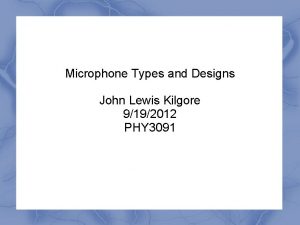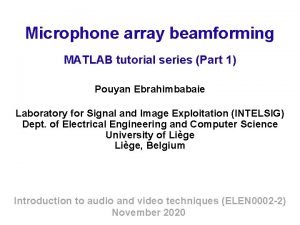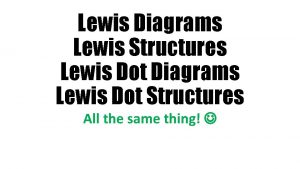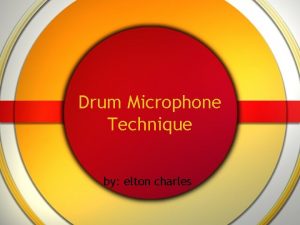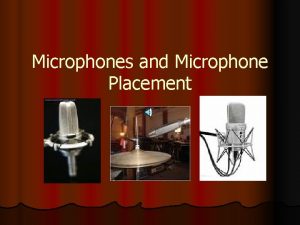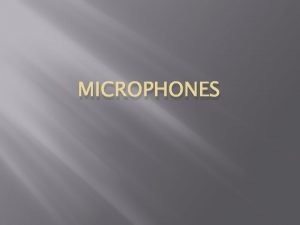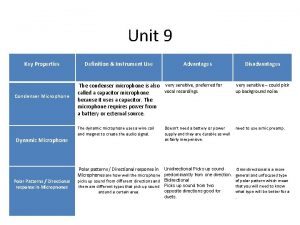Microphone Types and Designs John Lewis Kilgore 9192012

















- Slides: 17

Microphone Types and Designs John Lewis Kilgore 9/19/2012 PHY 3091

Introduction A microphone is a type of transducer. Early microphones were invented for communication purposes. Later modifications were made to design as the microphone was used more in entertainment industry.

Introduction Different situations call for the need of different microphone designs as well different pickup patterns. Need to consider factors such as the source, the location of the source and the environment of the source.

Overview of a Microphone Diaphragm—part of microphone which receives the vibration from sound waves. Thickness and material of diaphragm are changed depending on the sound waves you wish to pick up. How it works? Electrical circuit is used to change these detected vibrations into an electrical signal that “images” the sound with an output voltage or current.

Different Types of Microphones Microphone types we will discuss today: Carbon Button Ribbon Dynamic Condenser

Carbon Button Microphone— Historical Design Thomas Alva Edison and Sir Emile Berliner filled patents for Carbon Button Microphone in 1877. Edison's design became the accepted design and patent. This is a popular microphone for telephones as well as early radio and speeches.

Carbon Button Microphone Diaphragm: Thin Metal Plate The diaphragm is connected to a button full of carbon power. A voltage is applied across the button. Sound pressure changes the resistance through the button by compressing/decompressing the carbon by pushing the plate.

Carbon Button—Design Diagram

Ribbon Microphone Diaphragm: Thin piece of metal foil suspended in a magnetic field. Vibrations in ribbon produce a small voltage which is then stepped up by a transformer. Diaphragm is very easily damaged by wind or loud incoming sounds.

Ribbon Microphone— Design Diagram

Dynamic Microphone Diaphragm: Plastic Diaphragm pushes a coil of wire suspended in a magnetic field. Durable design and versatile use. A reverse of a loudspeaker.

Dynamic Microphone— Design Diagram

Condenser Microphone Diaphragm: Thin metal strip suspended next to a charged electric plate. This creates a capacitor. Diaphragm moves in and out and changes electrical capacitance. Requires a power source for the charged plate. Distorts easily and has a flat frequency response.

Condenser Microphone-Design Diagram

Frequency Response

Microphone Pickup Patterns Pickup patterns help to reduce unwanted signal from getting pickups Popular patterns: Monodirectional, Bidirectional, Cardioid, and Omnidirectional

Sources http: //www. mediacollege. com/audio/microphones/dynamic. htm lhttp: //www. cybergeo. com/music/microphones/ http: //hyperphysics. phy-astr. gsu. edu/hbase/audio/mic. html http: //lloydmicrophoneclassics. com/mic_history. html http: //en. wikipedia. org/wiki/Microphone http: //ffden-2. phys. uaf. edu/212_fall 2003. web. dir/David_Boniface. Jones/Page 2. htm
 John lewis microphone
John lewis microphone Computer input devices drawing
Computer input devices drawing Ribbon microphone advantages and disadvantages
Ribbon microphone advantages and disadvantages Types of research design
Types of research design Types of qualitative design in research
Types of qualitative design in research Types of methodologies
Types of methodologies Types of design structural and decorative
Types of design structural and decorative Quasi experiment advantages and disadvantages
Quasi experiment advantages and disadvantages Is descriptive correlational design quantitative
Is descriptive correlational design quantitative What is a research design
What is a research design 05032021
05032021 Descriptive genitive
Descriptive genitive Please mute your mic
Please mute your mic Please mute your microphone
Please mute your microphone Audio mic software
Audio mic software Jenis microphone dengan pattern
Jenis microphone dengan pattern Microphone array matlab
Microphone array matlab Please mute your phone
Please mute your phone
